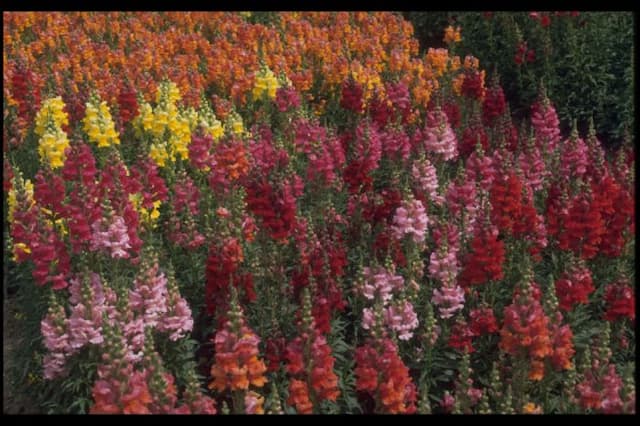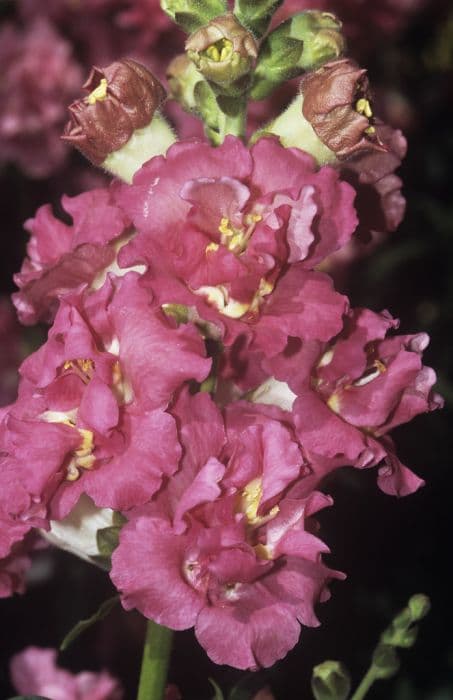Foxglove Digitalis × valinii 'Harkstead Flame' (PBR) (Illumination Series)

ABOUT
The plant known as 'Harkstead Flame' is a striking perennial that is part of the Illumination Series, showcasing a delightful blend of beauty and hardiness. This hybrid bears incredibly showy flowers, which are a warm blend of pink, peach, and orange tones. The tubular blossoms are gracefully stacked along the tall spires, creating an impressive display that resembles flames, which gives the 'Harkstead Flame' its name. The individual flowers are characterized by their spotted throats, which add an intricate pattern to their overall appeal. The foliage of 'Harkstead Flame' forms a rosette of large, hairy leaves that provide a lush, green backdrop to the vibrant blooms. The leaves are slightly serrated on the edges and have a texture that can be described as somewhat coarse to the touch. This adds to the visual interest as the soft leaf structure contrasts the bold, fiery colors of its blossoms. Dominating the scene when in bloom, 'Harkstead Flame' attracts pollinators such as bees, hummingbirds, and butterflies, enhancing its dynamism in the garden. This plant is particularly noted for its extended flowering period, which allows admirers to enjoy its vivid colors for a longer duration compared to many other perennials. The alluring combination of its foliage and blossoms makes 'Harkstead Flame' a favorite among gardeners looking to inject a touch of vibrancy into their landscape.
About this plant
 Names
NamesSynonyms
Foxlight Ruby Glow Foxglove, Illumination Flame Foxglove, Harkstead Flame Foxglove.
Common names
Digitalis × valinii 'Harkstead Flame' (PBR) (Illumination Series)
 Characteristics
CharacteristicsLife cycle
Perennials
Foliage type
Semi-evergreen
Color of leaves
Green
Flower color
Pink
Height
3 feet (91 cm)
Spread
18 inches (45 cm)
Plant type
Herb
Hardiness zones
4
Native area
Europe
Benefits
 General Benefits
General Benefits- Attracts Pollinators: The vibrant flowers of the Foxglove 'Harkstead Flame' draw in bees and beneficial insects, which are essential for the pollination of many plants.
- Long Blooming Season: It typically has a longer blooming period, providing color and interest in the garden for an extended time.
- Drought Resistance: Once established, 'Harkstead Flame' can tolerate periods of dryness, making it suitable for gardens with less frequent watering.
- Visual Appeal: The unique and striking flowers of 'Harkstead Flame' add a dramatic touch to any garden with their gradient of flame-like colors.
- Low Maintenance: This plant generally requires minimal care once established, making it a good choice for gardeners who want a beautiful garden without a lot of work.
- Perennial Growth: As a perennial, 'Harkstead Flame' will return year after year, providing lasting value and reducing the need for annual replanting.
- Vertical Interest: With its tall spikes of flowers, 'Harkstead Flame' can add vertical interest to garden beds, borders, or container plantings.
- Deer Resistance: It is less appealing to deer, which can be beneficial in areas where deer browsing is a problem for gardens.
 Medical Properties
Medical Properties- This plant is not used for medical purposes.
 Air-purifying Qualities
Air-purifying QualitiesThis plant is not specifically known for air purifying qualities.
 Other Uses
Other Uses- Plant dye: The flowers of Digitalis 'Harkstead Flame' may be used to create a natural dye for textiles, providing shades ranging from light yellow to green depending on the mordant used.
- Photography: With its striking blooms, Digitalis 'Harkstead Flame' can serve as an excellent subject for botanical photography, aiding in the study of plant structure and horticulture.
- Floral Arrangements: The tall, colorful spikes of Digitalis 'Harkstead Flame' make dramatic additions to cut flower arrangements, adding height and a touch of wild elegance.
- Educational tool: Students and educators can utilize the plant in botany classes to illustrate plant hybridization and breeding, as this plant is a result of cross-breeding.
- Culinary garnish: Although the plant is not edible and can be toxic, the flowers can be used as a non-consumable garnish for aesthetically enhancing dishes when removed before eating.
- Garden color theming: Use Digitalis 'Harkstead Flame' to create a vivid color theme in gardens, especially designed for fiery and warm color palettes.
- Artistic inspiration: Artists may draw inspiration from the intense colors and forms of 'Harkstead Flame' for paintings, textiles, and other creative works.
- Beekeeping attraction: Planting Digitalis 'Harkstead Flame' can help attract bees to an area, supporting local beekeeping efforts and contributing to pollination.
- Companion planting: Utilize the Digitalis 'Harkstead Flame' as a companion plant to attract pollinators that will benefit the surrounding fruit and vegetable crops.
- Themed events: Incorporate Digitalis 'Harkstead Flame' plants into event decorations, such as weddings or garden parties with a natural or rustic theme.
Interesting Facts
 Feng Shui
Feng ShuiThe Foxglove is not used in Feng Shui practice.
 Zodiac Sign Compitability
Zodiac Sign CompitabilityThe Foxglove is not used in astrology practice.
 Plant Symbolism
Plant Symbolism- Healing: The most common name for Digitalis x valinii 'Harkstead Flame' is Foxglove. Historically, foxglove plants have been used to create heart medications, symbolizing their ability to heal.
- Protection: Foxgloves are often associated with protection due to their toxic nature, which can deter predators and therefore symbolizes a protective barrier.
- Intuition: The speckled pattern inside the flowers of foxgloves is thought to mark where elves have touched the plant, giving it a mystical connection and symbolizing a link to inner knowledge and intuition.
- Insincerity: On a less positive note, because of the foxglove's poisonous attributes, it can sometimes represent insincerity or a false sense of security.
 Water
WaterThe Foxglove 'Harkstead Flame' should be watered deeply once a week, ensuring moisture reaches the roots. During the growing season, in the absence of rainfall, water this plant with approximately one gallon of water per week, depending on soil conditions and local climate. Always check the soil moisture level beforehand; if the top inch feels dry, it’s time to water. Avoid overhead watering to prevent disease, and instead water at the base of the plant. Be cautious of overwatering, as poor drainage can lead to root rot.
 Light
LightFoxglove 'Harkstead Flame' thrives in partial shade to full sun. The best spot for planting is one where the plant receives morning sunlight and some afternoon shade, as intense afternoon sun can be harsh. An east-facing garden spot is ideal because it provides the perfect balance of light for these flowers to flourish.
 Temperature
TemperatureFoxglove 'Harkstead Flame' performs best in temperate climates with ideal growing temperatures ranging from 60 to 75 degrees Fahrenheit. It can survive in temperatures as low as 40 degrees Fahrenheit and as high as 90 degrees Fahrenheit, although the plant may experience stress outside its ideal temperature range.
 Pruning
PruningFoxglove 'Harkstead Flame' should be pruned to promote bushier growth and to remove spent flower spikes after blooming to encourage a second flush of flowers. Prune the plant by cutting the spent flower stalks back to the basal leaves. Pruning can be done as needed throughout the blooming season, generally from late spring through early fall.
 Cleaning
CleaningAs needed
 Soil
SoilFor Foxglove 'Illumination Flame', the best soil mix is well-draining, rich in organic matter, and with a pH of 5.5 to 6.5. Amend the soil with peat moss, perlite, and compost to improve texture and nutrients.
 Repotting
RepottingFoxglove 'Illumination Flame' typically does not need frequent repotting; do it every 2-3 years or when it outgrows its container.
 Humidity & Misting
Humidity & MistingFoxglove 'Illumination Flame' prefers moderate humidity levels; aim for 40-60% to keep it thriving.
 Suitable locations
Suitable locationsIndoor
Place in bright, indirect light and ensure the soil is well-drained.
Outdoor
Plant in partial shade, sheltered from strong winds, in moist soil.
Hardiness zone
4-9 USDA
 Life cycle
Life cycleDigitalis 'Harkstead Flame' begins its life cycle as a seed, which upon germinating in favorable conditions, grows into a seedling with a rosette of leaves at the ground level. As a perennial plant, it develops sturdy stems and a robust root system in its first year, storing energy for future growth. In the second year, it produces tall spikes adorned with tubular, vibrant orange-pink flowers that are attractive to pollinators such as bees and hummingbirds. After the flowering stage, the plant sets seed, which can be dispersed to produce new plants. Unlike some perennials, Digitalis 'Harkstead Flame' does not have a pronounced dormancy period but may die back somewhat in winter, only to regrow from the base in spring. The plant may live for several years, but the vigor and flower production may diminish over time, at which point gardeners may choose to propagate from cuttings or renew the plant from seeds.
 Propogation
PropogationPropogation time
Spring-Early Summer
Propogation: For Digitalis × valinii 'Harkstead Flame' (also known as Foxglove), the most popular method of propagation is by seed. Since this hybrid variety is patented, asexual propagation may be prohibited without permission from the patent holder. To propagate Foxglove by seed, one should sow seeds directly into the garden after the last frost has passed in spring, or start them indoors about 8 weeks before the last expected frost. Seedlings need to be kept moist and it's advisable to cover the seeds lightly with soil as they require darkness to germinate, which typically takes about 14 to 21 days. Once the seedlings are large enough to handle, they should be thinned out or transferred to individual pots, being careful not to damage the delicate roots. Plant them out into their final positions after the risk of frost has passed and they have grown strong enough to survive the elements.





![Snapdragon [Pretty in Pink]](/_next/image?url=https%3A%2F%2Fplants-admin.emdemapps.com%2Fimages%2Fplants%2F%2Fimages%2F604b5cb3b5385.png&w=640&q=75)



